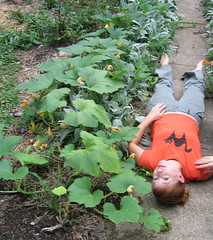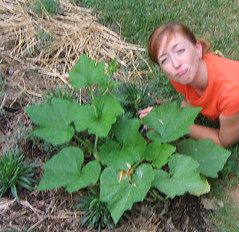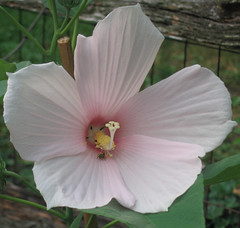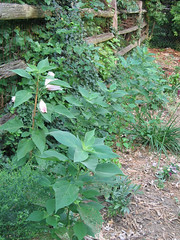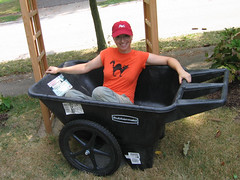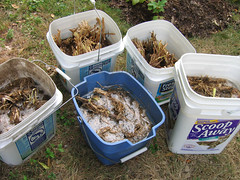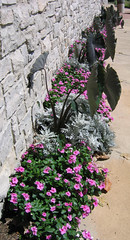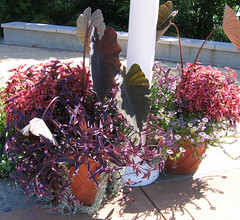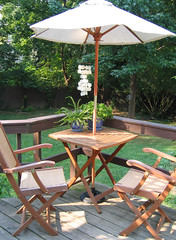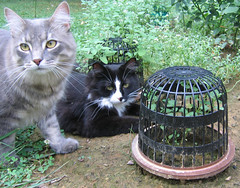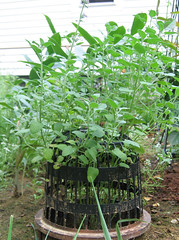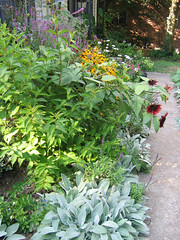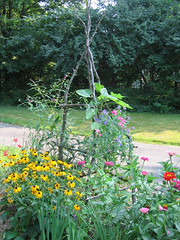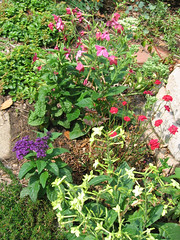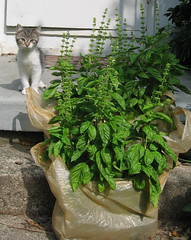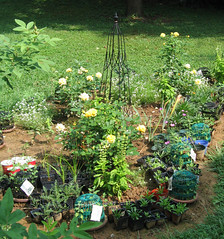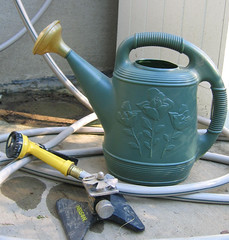
You won’t find any fancy product plugs here. I use very basic tools to water my garden, with the exception of an experimental deep watering device (sounds Top Secret, huh?).
Hose. Yup, I use a regular old hose. It isn’t a soaker hose. It isn’t a coily hose. It isn't a "never kink" hose. It’s a medium-duty, plain hose. I only had two requirements when I bought my hoses. First, they had to reach from the house to the areas I need to water. A 150 foot hose in front and another in back meet my needs. Second, the hose had to color coordinate with the house color. That may sound superficial, but the front hose is very visible and I didn’t want it to be the first thing I noticed as I walked up to the house. I’ve seen hose hiders for sale, but I couldn’t convince myself that they would be easy to use. I managed to find a pale gray hose to somewhat blend in with my white house. I honestly think there could be a market for color-coordinated hoses. At least they could come in white and brown.
Sprayer Attachment. This is usually set on “gentle shower” so that I can use it to water my plants with the hose. The much more chic attachment would be a watering wand, but I bought the sprayer before I’d even heard of such a thing. And the sprayer was only 50 cents at a garage sale. And, before I bought a longer hose for the backyard, I needed the spraying function in order to reach some of my plants with the water. Now, I’d consider a watering wand, but only if it was gifted to me. In absence of the sprayer (or wand), I’ve found that a thumb works quite well.
Sprinkler. This is another fairly basic tool. I use it to give entire beds a good soaking. Yes, a sprinkler has its pitfalls. It is not as efficient (due to evaporation) as other methods (like a soaker hose) and it sprays water on the foliage, increasing the chance of fungus problems. In the sprinkler’s defense, I think the evaporation isn’t all that bad because it tends to cool the air in the general vicinity, providing relief to plants, people, and cats alike. I also haven’t had a single case of mildew, so I am starting to think that sprinkler’s reputation has been maligned. However, I’m not a total lost cause when it comes to water conservation. I plan on putting soaker hoses in two areas I currently sprinkle, cutting back on evaporation and the chance of mildew.
My sprinkler sends out a circular spray of water, but sometimes I need just a half-arc. I would like a sprinkler with adjustable water patterns, so that I can minimize water waste. I’ve seen models with a selection plate and models with individual nozzles that can be aimed in the desired direction. I may consider buying one of these next year.
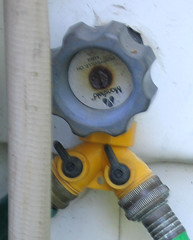 Hose Splitter
Hose Splitter. This is perhaps my favorite watering gadget. It turns one spigot into two. Using the selection levers, I can simultaneously sprinkle a flower bed and fill my watering jug. I need a second splitter for the backyard. The best part about this gadget is that Mike doesn't understand how it works, so he never knows which hose will have water coming out of it!
Watering Can. While my front yard hose is long enough to water all of the containers, maneuvering it to certain areas can be difficult. To water the containers near the driveway, I prefer to fill the can and carry it. I also use the can for spot watering newly planted, or just very thirsty, plants. I usually reserve the sprinkler’s use for entire beds in need of water.
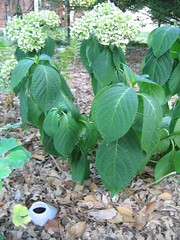 Holey Milk Jug
Holey Milk Jug. Because I DO care about water conservation, I have a holey milk jug in clinical trials in the front yard. For those of you not familiar with this method, this is how it works:
- Take a clean milk jug, minus the cap.
- Punch a bunch of little holes in the bottom.
- Dig a hole next to your thirsty plant.
- Bury the milk jug so that just its opening is showing.
- Water the plant by filling the jug.
Supposedly, the jug will slowly deliver water directly to the plants roots, minimizing evaporation and encouraging deep root development. So far, I have to give the holey milk jug a big thumbs down. Maybe I punched too many holes, but I have to put far more than a gallon of water into the jug before it fills to the top. Then, it quickly drains. My thirsty hydrangea (the experimental subject) still wilts and pouts nightly. I’m not sure I’ll be burying anymore jugs. Frankly, even partially covered with leaves, it looks like I’m gardening in a garbage dump.
Minus the jug, these are all the watering tools a beginning gardener really needs. I’ll be upgrading to some fancier gadgets next year (my 3rd season of gardening), but they are only a convenience, not a necessity. The milk jug is probably going in the trash.
